Darker dangers ignored in Hong Kong's youth drug abuse figures
Jingan Young says the finding of falling drug use among Hong Kong youth does not reflect the full extent of the danger of abuse they face

Last week, Narcotics Commissioner Erika Hui Lam Yin-ming relayed the results from the Central Registry of Drug Abuse survey of local and international school students. Rather predictably, the number of reported and new drug users aged under 21 last year dropped by 20 per cent and 21 per cent, respectively, in comparison to 2011. The survey, the agency hastened to add, also showed a significant dip in under-21 ketamine and Ecstasy users from 2008/09 to 2011/12.
You may recall that, over the past decade, the number of psychotropic drug addicts so spiralled out of control that it even garnered its own nickname, "down in Hong Kong, down the K-Hole". Cannabis, it seems, has taken its place as the drug of choice.
The overall drop may be good news, but what about the large number of individuals who remain "hidden" - those whose problems are not reported, who remain unaware they have a problem, or just refuse to seek help?
The Hong Kong survey is problematic for a number of reasons. The questionnaire format ignores the individual and, arguably, is tailored to uncover a favourable result.
However, there were some revelations, such as the contradiction of the widely held notion that living in public rental housing leads to addiction. In fact, there was little difference between the figures for drug-taking students living in public and private housing.
And it would appear that "friends" supply both the drugs and the location to take them. Is peer pressure to blame?